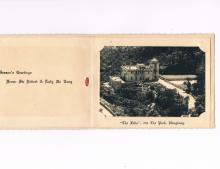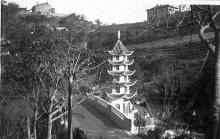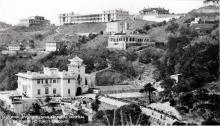The Falls (2nd generation) / Ho Tung Gardens [1927-2013]
Primary tabs
Submitted by annelisec on Sat, 2010-01-02 12:45
Current condition:
Demolished / No longer exists
Date Place completed:
1927-01-01
Date Place demolished:
2013-10-25
Tags:





Comments
Two stories
"In the rainy season there actually was a waterfall there. Some of the water was used to fill a swimming pool, and this was no doubt one of its main attractions for my parents. Messrs. Palmer and Turner, the leading architects in those days, drew the plans ..."
The above from "Clara Ho Tung, a Hong Kong lady: her family and her times" By Irene Cheng (her daughter). There is much more about the building of the house and the Buddhist Temple on the grounds.
You can check out a copy from the Public Library.
-----------------------
Second we have ... Historic Building AppraisalHo Tung Gardens.
[click here for the original document. The (...) should be the names in Chinese, but I don't have the right editor.]
Ho Tung Gardens (....), also known as Hiu Kok Yuen (...), is a residential house with extensive gardens. The name “Hiu Kok” (..) is derived from the names of the couple Ho Hiu-sang (...) (alias Sir Robert Ho Tung ..) (1862-1956) and Lady Clara Ho Cheung Lin-kok (... .) (1878-1938). It was designed by the well-known local architectural practice of Palmer and Turner. The main building was built in circa 1927 while the ornamental gateway (pai-lou, ..) at the entrance was completed in 1938.
Lady Clara Ho Tung died in 1938, so the gateway might have been built to commemorate her. The site was formerly known in English as “The Falls” because of the presence of a mountain stream nearby.
The site includes a gateway, a four-storey main building, a Chinese style garden with a bridge, a swimming pool, a five-storey pagoda and pavilions. Calligraphies of high-ranking officials of the Qing government such as Zeng guo-fan (...) and Zuo Zong-tang (...) could be found in the garden. The main house of the garden once received many famous figures, e.g., the Irish scriptwriter George Bernard Shaw (...) (1856-1950) and Kang You-wei (...).
The house was requisitioned by the military authorities as a military base to fight against the Japanese troops in 1941. The military authorities set up two posts on the roof of the house to shoot at ships at sea. As a result of heavy fighting, the house fell into ruin particularly the roof of the ancestral shrine, the bedrooms and elsewhere in the house and in the grounds. Afterwards, Sir Robert Ho Tung sent a letter to Colonel Secretary asking for ompensation in 1946, and the house underwent several renovations.
Historical Interest.
The main residence which is built in the Chinese Renaissance style is situated in a large garden which has a Chinese pavilion, a Chinese pagoda, a Chinese gateway, a tennis court, a swimming pool and a garage. The residence is basically two-storied with white painted walls and rectangular windows of various sizes united by horizontal bands. An octagonal tower with a hipped Chinese tiled roof with ridge and finial ornaments is situated at one corner. A square tower of similar design but resembling an Italianate campanile with arched windows and doorway is another striking feature of the building. Except for the Chinese tiled roofs to the towers, the roof of the building is flat. The pavilion and pagoda in the garden are reinforced concrete structures with Chinese tiled roofs. The main gateway is constructed of granite and is believed to have been built in 1938, the year Lady Clara Ho Tung passed away.
Architectural Merit
Although Chinese Renaissance style can be found elsewhere in Hong Kong, the design of Ho Tung Gardens appears to be unique. As the residence of Sir Robert Ho Tung it has obvious historical value as well as built heritage value. There are no obvious alterations to the exterior so that the building retains its authenticity. The garden structures are interesting examples of Chinese architecture.
Rarity, Built Heritage Value & Authenticity
The social value of Ho Tung Gardens lies in the role it played as the residence of the rich Eurasian businessman and philanthropist, Sir Robert Ho Tung. It has strong associations with historic events, phases and activities in Hong Kong as well as connections with famous and historic figures. It therefore has a great deal of local interest for historians. The surroundings of the Ho Tung Garden, The Peak, is made up of residential buildings having similar height and a lower density that offer a quiet, low density and relaxed environment. Furthermore, the mountain setting, lush greenery and broad views compliment this heritage building.
Social Value & Local Interest Immediate Environs
It is considered that adaptive re-use might harm the integrity and authenticity of the residence if it had to undergo fitting out, alterations and installation of modern conveniences and building services installations. Its future is unknown at present but it is hoped that it can be preserved and perhaps opened to the public.
Remarks:
Ho Tung Gardens has not yet been graded, but it is on the Antiquities and
Monuments Office’s list of recorded items.
Not yet graded
Ho Tung Garden at Peak Road to be declared Proposed Monument
T writes:
This just in. Just read it in Ming Pao instant News. Don't know if it is good news or bad.
80skid:
It's great news: prompted by this (as in Thomas's link)
10. Under our monitoring system established to monitor any submission to relevant Government departments on proposed works that may affect monuments and historic buildings, it has been brought to our attention that the owner has submitted to the Buildings Department (BD) a building plan and a demolition plan with regard to Ho Tung Gardens for developing 11 houses.
Both plans have recently been approved by BD as they comply with all the relevant requirements under the Buildings Ordinance, which regulates building safety...
Seems the owner didn't care much for the building's history:
In response to the proposal to accord Grade 1 status to Ho Tung Gardens, the owner wrote to AMO in July 2010 to express her disagreement with the proposed Grade 1 status and provide additional information on Ho Tung Gardens. The owner did not agree with the proposed Grade 1 status mainly because, as she indicated, Sir Robert Ho Tung did not live in Ho Tung Gardens, no important family events had been held there and the interior of the buildings there had undergone considerable alterations, etc.
A copy of the owner’s letter has been provided to Members separately. Tung Gardens has high heritage value warranting a Grade 1 status, since it is the only remaining residence directly related to Sir Robert Ho Tung locally and in view of the rarity of historic buildings in Chinese Renaissance architectural style in Hong Kong. Accordingly, we recommend the Board to confirm according Grade 1 status to Ho Tung Gardens.
Annelise:
Thank you Bernard Chan ! (of the AMO). He had the power to force the Buildings Department to be transparent regarding historical sites. We have a watchdog who actually watches ! Bravo AMO.
However this will now eclipse media coverage of 23 Coombe Road. The current Ho Tung Gardens dates from post war - not the 1880's like Coombe Road.
Here's a book that includes descriptions of Ho Tung Garden, known then as "The Falls"
Ho Tung Gardens
The Antiquities Advisory Board has approved a government proposal to declare the Ho Tung Gardens on the Peak a monument. The owner of the villa had wanted to redevelop the site. The villa was built and named for Robert Hotung in the 1920's (RTHK)
Full appraisal here: http://www.lcsd.gov.hk/ce/Museum/Monument/form/briefing/htgaa_report.pdf
re: Ho Tung Gardens
another victim of Hong Kong's failure to preserve privately owned buildings. Demolition complete. from HK Standard today.
Demolition of the historic Ho Tung Gardens was completed yesterday - and the owner might be eyeing big money from redeveloping the site.
Ho Min-kwan, granddaughter of the late tycoon Robert Hotung, failed to sell the 120,000-square-foot site - including the mansion built in 1927 - at 75 Peak Road when she put it on the market for HK$4.5 billion in May, say property agents.
So Ho, 71, might have to go back to her original plan of last year to develop the site for 12 townhouses after demolishing the Chinese renaissance- style mansion.
Surveyors estimate she could get at least HK$25 billion with the new plan.
The government's dream of preserving the gardens is finally at rest. It has been negotiating with Ho since in 2011.
Demolition of the mansion began in July this year.
I've updated the name of this
I've updated the name of this Place to show that it was originally called The Falls - see this christmas card:
Ho Tung Gardens
I was sad to hear that Ho Tung Gardens has been demolished. Such a shame. I remember it well when I lived just around the corner at Stewart Terrace with my parents between 1960-62. As a young boy I used to sneak into the old gardens, which were extremely overgrown even then with my dog and explore the grounds including the area where the small waterfall was located. It's unfortunate that the Government didn't protect the property. Robert